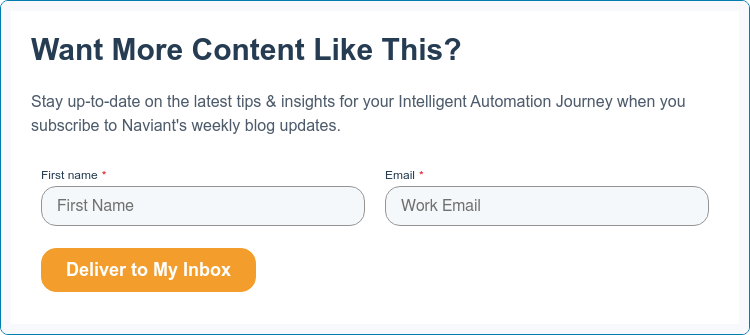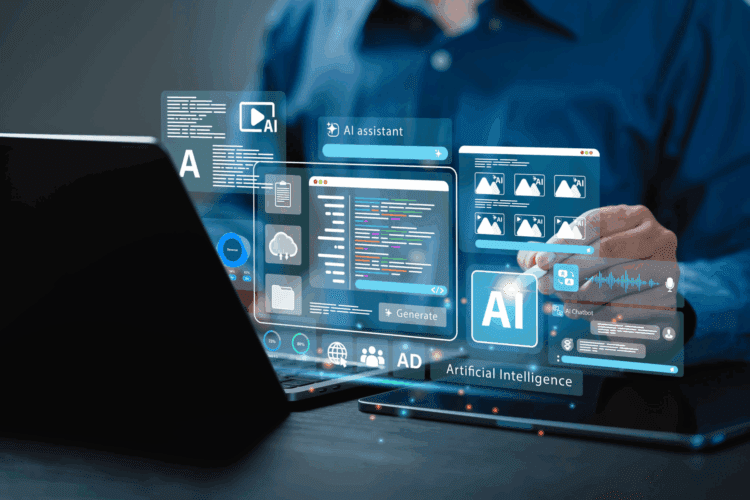Whether you’re an intelligent automation newcomer or an industry veteran, you know all too well how many acronyms the enterprise software industry uses. If it trips you up regularly, know that you’re not alone.
Managing your organization’s intelligent automation journey is challenging enough on its own, let alone memorizing and understanding the meaning behind the growing list of acronyms that get thrown around daily.
To simplify this obstacle, we’ve compiled a list of the top 10 most common intelligent automation acronyms you’ll run into, complete with breakdowns of how each one fits into your intelligent automation strategy to solve your business challenges. This way, you’ll get the rundown once and for all. And if you think it’ll be helpful, consider bookmarking this article for future reference.
What Acronyms Do You Need to Know When Talking About Intelligent Automation?
1. OCR – Optical Character Recognition
Optical Character Recognition (OCR) is a technology that converts unstructured data like printed or handwritten text into machine-readable text, or structured data. It involves software and sometimes hardware to recognize and extract text in a variety of human languages from documents, images, or other sources, making it accessible and editable in a digital format. It’s an invaluable tool for any organization burdened by manual data entry. Plus, it lets you make more informed decisions from data that would otherwise be trapped in a pile of paper, and that’s data you can act on and integrate into your existing systems.
There are different types of OCR, including traditional OCR, which recognizes printed text, and Intelligent Character Recognition (ICR), which can recognize and process handwritten text. OCR technology is widely used in various industries, such as banking, healthcare, legal, and education. For example, in banking, OCR is used to process checks and extract information from financial documents. In healthcare, it helps digitize patient records and streamline administrative tasks.
How Does It Fit Within Your Intelligent Automation Strategy?
OCR plays a significant role in a intelligent automation strategy, particularly in document management and automation. Here are a few examples of how OCR can be integrated into your intelligent automation strategy:
- Data Extraction and Integration: OCR can extract valuable data from documents and images, making it easier to integrate this information into various digital systems.
- Search and Retrieval: OCR enables full-text search capabilities, making it easier to find and retrieve specific information from a vast digital document repository. This is particularly valuable in compliance and legal contexts.
- Streamlined Workflows: OCR can be integrated into business process management (BPM) systems. When combined with BPM, it automates document routing and processing, reducing manual intervention and speeding up processes.
2. IoT – Internet of Things
The Internet of Things (IoT) is a broader concept, and it refers to the network of interconnected objects and devices that can collect and exchange data. These devices often have sensors and connectivity, allowing them to transmit data over the internet. IoT technology is used to monitor, control, and optimize various processes and systems.
IoT applications span across various industries, including healthcare, agriculture, manufacturing, and smart cities. For example, in healthcare, IoT devices can monitor patients’ vital signs in real-time, enabling remote care and early detection of health issues. In agriculture, IoT sensors can track soil moisture levels and weather conditions to optimize irrigation and crop management.
How Does It Fit Within Your Intelligent Automation Strategy?
IoT can be a game-changer for your intelligent automation journey by enabling real-time data collection and analysis.
Integrating IoT devices into your strategy can enable:
- More efficient operations
- Predictive maintenance
- Data-driven decision-making
- Better overall business performance
3. AI – Artificial Intelligence
Artificial Intelligence (AI) is one of the most common intelligent automation acronyms today. It’s often associated with machines that mimic human intelligence, and it’s exploded into the mainstream with tools like ChatGPT.
Artificial intelligence (AI) applications span across various industries, including healthcare, finance, manufacturing, and entertainment. For example, in healthcare, artificial intelligence can assist in diagnosing diseases, predicting patient outcomes, and personalizing treatment plans. In finance, artificial intelligence is used for fraud detection, algorithmic trading, and customer service automation. In manufacturing, artificial intelligence helps optimize production processes, predict maintenance needs, and improve quality control. with machines that mimic human intelligence, and it’s exploded into the mainstream with generative AI tools like ChatGPT.
How Does It Fit Within Your Intelligent Automation Strategy?
A great way to explore the use of AI systems within your business is to leverage Optical Character Recognition (OCR) and Process Discovery Tools that leverage AI to automate tasks and provide valuable business insights. Capabilities to look for include:
- The Ability to Learn: Over time, the solution should be able to learn from the processes it interacts with, identifying patterns and becoming more effective in the process.
- Use of Contextual Information: The tool should be able to gather context similar to how a human brain can and apply it.
- Validate Information and Self-Correct: The tool should be able to identify that the task is likely to be unsuccessful and either modify its approach or flag it as an exception.
4. UX – User Experience
User Experience (UX) refers to how users interact with digital products and services. It encompasses design, usability, and overall satisfaction with the user interface. Improving UX is essential for enhancing customer satisfaction and driving engagement.
A well-designed UX ensures that users can easily navigate and accomplish their goals within a product or service. It focuses on creating intuitive and enjoyable experiences that meet users’ needs and expectations. Key aspects of UX include user research, prototyping, usability testing, and iterative design.
How Does It Fit Within Your Intelligent Automation Strategy?
Prioritizing UX in your intelligent automation strategy is crucial for creating user-friendly and engaging digital solutions.
By ensuring a positive UX, you can:
- Increase customer retention
- Improve conversion rates
- Boost overall satisfaction with your digital offerings
5. BPM – Business Process Management
Business Process Management (BPM) tools let you optimize your processes with automated workflows and provide visibility to monitor your business’s overall health. BPM can be used to manage processes that follow a linear path and documents or objects are routed throughout the organization by rules and logic.
BPM tools can be categorized into different types, including human-centric BPM, which focuses on processes involving human tasks and interactions, document-centric BPM, which deals with processes that revolve around document management, and integration-centric BPM, which integrates various systems and applications to streamline processes.
How Does It Fit Within Your Intelligent Automation Strategy?
BPM or Workflow is often the first step that organizations take on their automation journey. The tried-and-true method of electronically routing information allows you to instantly limit the amount of paper within your organization and increase visibility into process bottlenecks. When looking for a scalable Workflow solution, make sure that your solution includes:
- Point-and-Click Configuration: A configurable tool allows for quick automation for your business processes, and with no need for custom coding.
- Electronic Forms: Expedite your processes further by eliminating paper and improve information accuracy with features like required fields and data validation.
- Reporting Capabilities: Deliver real-time insights into your processes to identify opportunities for improvement and quickly respond to changes in performance.
6. RAD – Rapid Application Development
Another hot intelligent automation Acronym is RAD, or Rapid Application Development. RAD platforms, also known as low-code solutions, finally settle the adage of “Buy vs. Build”. With RAD solutions, you get the benefits of a custom solution that typically would have required custom coding, but with the speed of an off-the-shelf solution.
These platforms are widely used across various industries, such as finance, healthcare, manufacturing, and government. For example, in finance, RAD platforms can automate loan processing and compliance checks, while in healthcare, they can streamline patient record management and billing processes.
How Does It Fit Within Your Intelligent Automation Strategy?
You can use these tools to quickly replace aging database applications while filling in the functionality gaps that exist between your line-of-business systems. A RAD application should give you the freedom to:
- Build Rather Than Code: You shouldn’t need to be a developer to create and extend your solutions. Training is certainly needed, but you should be able to leverage checkboxes, radio buttons, and drop-down menus to configure and change solutions.
- Minimize IT Sprawl: You can realize a lower total cost of ownership by minimizing the need for multiple niche vendors and time-consuming, costly custom coding. Your IT team can also focus on bringing new solutions to life, rather than supporting a string of unrelated applications.
- Respond to the Business: Point-and-click configuration allows you to deliver solutions at the speed that end-users expect. You can also meet complex process needs or changing requirements and tailor solutions to specific business needs without custom coding.
7. RPA – Robotic Process Automation
Robotic Process Automation (RPA) is a common intelligent automation acronym referring to software that automates structured business processes, going beyond traditional automation capabilities. Specifically, the robots act as virtual workers to complete repetitive tasks, just as a person would. However, they can do it with greater operational efficiency and accuracy, and at a fraction of the cost.
These tools are widely used across various industries, such as finance, healthcare, manufacturing, and telecommunications. For example, in finance, RPA can automate loan processing and compliance checks, while in healthcare, it can streamline patient record management and billing processes.
How Does It Fit Within Your Intelligent Automation Strategy?
RPA can be used 24/7 behind the scenes to perform tasks that are high-volume, repetitive, and time-consuming. Additionally, it can help your team to leverage an attended bot that can automate processes on demand. Set your RPA journey up for success with:
- Process Discovery: Using AI, machine learning, and neural networks, Process Discovery and Process Mining shows you exactly where to automate for a better ROI.
- Attended Automation: End-users can choose whether to have a Robot assist them in completing a task or do it for them – directly from their desktop.
- Unattended Automation– Eliminate human oversight by assigning human error-prone processes to your virtual workers to execute without intervention.
8. API – Application Programming Interface
An Application Programming Interface (API) defines the rules and protocols for interacting with software applications. APIs let different software systems to communicate and share data, facilitating integration between various applications and services.
Then, there’s API-First. This offshoot term refers to the approach that prioritizes the development and design of APIs before building other components of a software application. This approach ensures that APIs are well-designed and flexible, enabling easy integration and scalability.
How Does It Fit Within Your Intelligent Automation Strategy?
APIs are crucial in connecting disparate systems and enabling data flow across an organization. Specifically, they are essential for building a cohesive digital ecosystem, allowing different software components to work together seamlessly and enhancing data accessibility and integration.
9. SaaS – Software as a Service
Software as a service (SaaS) is a lesser-known intelligent automation acronym referring to the software distribution model where a third-party provider hosts an application. It also makes them available over the Internet, versus being hosted on-premise. Often, SaaS solutions are also referred to as Cloud-hosted solutions.
SaaS solutions can be categorized into different types, including horizontal SaaS, which serves a wide range of industries and functions, and vertical SaaS, which is tailored to specific industries or business needs.
How Does It Fit Within Your Intelligent Automation Strategy?
The most obvious benefit of SaaS application is the infrastructure savings that comes with hosting in the cloud. However, they can also help you with:
- Scalability: SaaS solutions can evolve right along with your changing business needs. For example, they can scale to accommodate additional infrastructure and storage needs.
- Support of the Solution: The best cloud-based providers have service level agreements or SLAs. These SLAs mandate they address any issues immediately. Additionally, there is 24/7 support available in the event of any disruption to service.
- Security: The level of security provided by reputable data centers that run private, managed clouds is higher than the security an organization could practically provide or afford for itself.
10. ML- Machine Learning
Machine Learning (ML) is a subset of AI that uses algorithms to help systems to learn from and analyze data and boost their performance without the need for explicit programming.
Machine learning applications span across various industries, such as healthcare, finance, manufacturing, and retail. For example, in healthcare, ML can assist in diagnosing diseases, predicting patient outcomes, and personalizing treatment plans, and in finance, ML is used for fraud detection, algorithmic trading, and customer service automation.
How Does It Fit Within Your Intelligent Automation Strategy?
Implementing ML can enable predictive analytics, personalization, and automation, contributing to more intelligent and responsive digital services and products.







